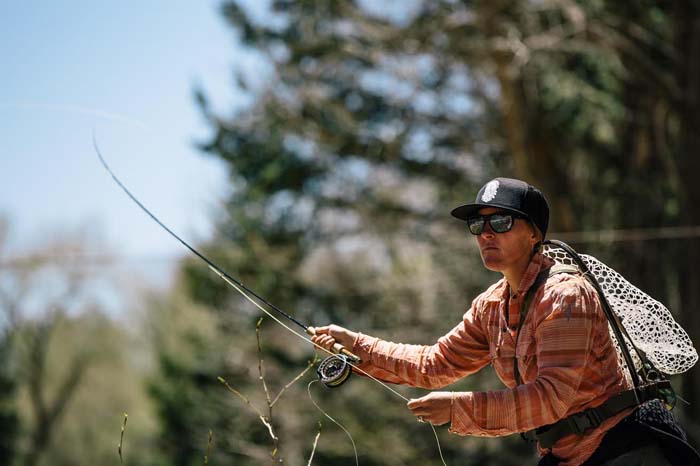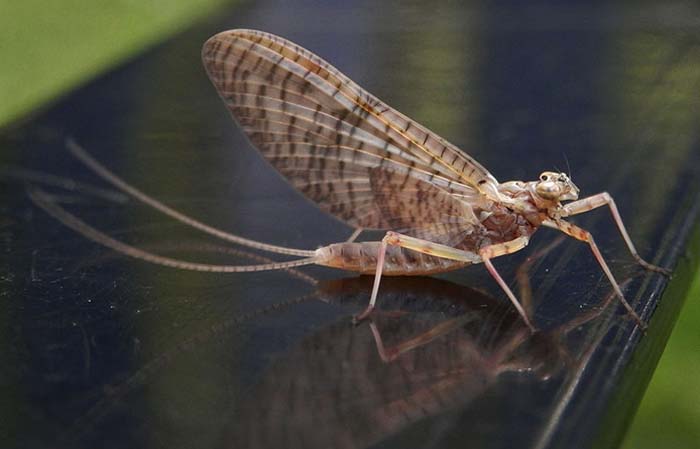
Mayfly (Ephemeroptera) in Guelph, Ontario, Canada. Photo credit Ryan Hodnett – a commons image.
There is no end to black ink on white paper about how to catch trouts with Ephemeroptera look-a-likes
by Skip Clement
[dropcap]T[/dropcap]he gold standard and the famed tagline “Match the Hatch” guides thousands, worldwide, every single day of the year. It came from Ernest Schwiebert, originating with his 1955 book Matching the Hatch: Practical Guide to Imitation of Insects Found on Eastern and Western Trout Waters.
Matching the hatch does of course work, obedience to it best if on home waters often fished – knowledge is wisdom. Or, if you’ve hired a local professional guide. I’ve almost never been a regular anywhere so I mostly have found rising, shucking, emerging, flying and falling Ephemeroptera often frustrating to “match.”
Naturally, there have been amazing days matching, but you’d expect that to happen a few times in nearly 70 years of flinging mayflies in all their forms. Maybe what I least liked was changing flies every five or ten minutes – not fun… for me.
NOTE: Matching The Hatch set the standard for fly entomology and tying studies for the late 20th Century. Ernest Schwiebert honors: IGFA Fishing Hall of Fame – 2013; American Museum of Fly Fishing, 2005; and Catskill Fly Fishing Center & Museum,
Art Lee was my hero; he said no to the endless pursuit of matching the hatch. I was immediately cleared of all charges
He saved many from living in a sanatorium for ‘troutsters’ who went bonkers trying to get salmonids to bite on their perfectly tied Ephemeroptera.
If a hatch is on, I’ll give it a go, but to keep my sanity, no hour will ever again be devoted to that battle cry of match the hatch and no bites.

The Mayfly (Ephemeroptera) has been perplexing anglers of the fly since time began – sort of. Image is “Frontpiece” from Spring-Tide – The Angler and His Friends, by George Akerman, London, (1852). Source: Extracted from public domain on the Internet Archive. Author Mike Cline.
Instead, why not do it Potter style? It’s fool-proof
The Potter brothers from Pittsburgh, Pennsylvania, Tad and Tom, the best trout fly fishers I ever knew, each carried a piece of mosquito screening, the smallest mesh, that they pressed against their shins while shuffling upstream a few inches at a time. It revealed all you’d ever need to know about what lived or was hatching on the stretch of whatever stream or river you were fishing. Everything was explained, everything.
Once, out west, fishing the world famous Silver Creek Preserve in Idaho for the snobbiest browns on earth, I watched an intrepid angler study, visually, his target brown trouts upwards to an hour as dusk came. Then he set his sniper foot in the water.
He seemed as puzzled at his outcomes as most do on that hallowed water
I had no doubt believing he had isolated what most browns fed on that evening (or thought they did). What lacked was not the latter, but what did was his casting. He was a terrible caster. He was so bad that an explanation would be analogous to being dressed in black tails at a hosted 19th century English Manor dinner party and perform like a two-year-old in a high-chair with a bowl of spaghetti, funny, but not pretty. And no chance of ever catching a trout.
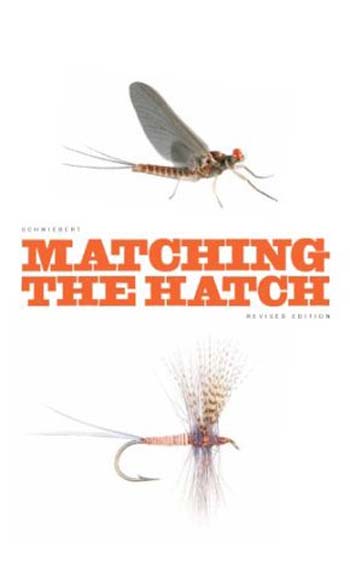
Above, the newest version (Ernest G. Schwiebert, James Prosek – Foreword) go to Amazon.
My seining screen has flexible plastic dowels attached at either end. It folds up
Reading the water, I will be fishing takes all of five minutes in which time I usually disrupt a few sections of water, collect the shuffled-up to see what lives in or is emerging from the water, as well as, lives under or on rocks. When done, I know what’s happening in that immediate water.
Rarely, do I fail to have a trout or bass hors d’oeuvre, a fly mimic from my fly box, get murdered by a passing or waiting trout or bass. That said, a lot of missed connections come from my casting performance… lost if I kerplunked my cast, lined fish, kissed the water too far left, right, short, or long. With those errors, I end with a rejection or gone for good trout or bass. If I get the cast right; bingo, an eat – may take a while, but it will happen, and knowing that makes fishing time immensely enjoyable.
Too, when the water is sick with bugs – say four hundred bugs in a square yard (just picking a number), what chance does my making it four hundred and one make? None. If you like to gamble and are prone to enjoying smiles earned try the tierra como things – think ants, spiders, and beetles.
If I have what I call a “deadbeat seining shuffle” – nothing identifiable standing out or visible surface hatch goin’ on, I’m prone to terrestrial-ize my “hors d’oeuvre.” Ants, worms, and spiders get first ‘dibs’ followed by beetles and such – all get swum differently. Spiders, according to Joe Brooks, need to be “skated” with an attention to their being on top of the water – not in it. Ants need to be on the water as well.
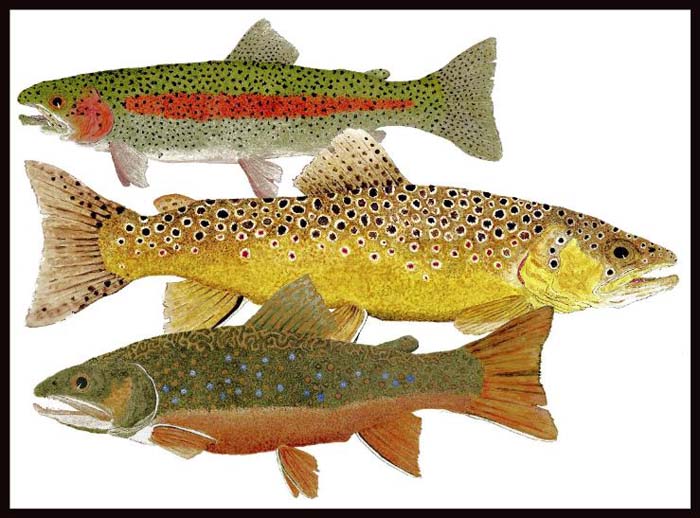
Rainbow, brown, and brook trouts by renowned watercolorist Thom Glace.
Mousing and streamers are for another time and whole new enchladas
It doesn’t matter to me that there are no visible examples of terrestrials about – they’ll hit them anyway – year round’ in fact. More aggressively, obviously, in the summer months.
Giving matching another try and hedging your bet
If I can see that trouts are near the surface, hanging-out a foot or so below the surface when the top-water is rife with bugs, I’ll switch to a short dropper using a “shuck-stuck” bug (sloppily tied on purpose – dubbing extravaganza) about a foot down +/-.
Sometimes that dropper will get mauled if it can be kept in the trouts up-looking depth window (not below its view) or at least in its landscape viewing periphery. Trouts hanging below the surface is always a good bet when there’s a flood on bugs on the surface, especially if the salminoids are not taxed holding their position.
One more idea, unmatch the hatch
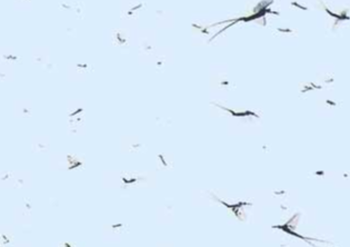
“One of the most famous mayfly hatches in Pennsylvania and throughout the eastern United States is the Green Drake.” — TroutBum.com
Some of the most unusual takes during robust hatches have come from an idea I thought I invented, but it turns out not even close – unmatch the hatch.
The greatest hatches I’ve ever witnessed happened yards away from Cedar Run Inn. Cedar Run is an unincorporated community in Brown Township, Lycoming County, Pennsylvania (west central PA).
Pine Creek and its tributaries, like Slate Run, or other nearby waters host a Green Drake hatch once a year around June. It’s a miracle to watch and to fish, but when the hatch is in full bloom, you’re adding a perfect copy of the drake in any of its forms and getting eaten is near the odds of winning the lottery.
One day’s disappointments were lessons not to be repeated
Big hatches that film-flood the water, of any kind, now get played with don’t match the hatch. My pursuit of that alone has been the best producer of strikes. That means a “pouch” full of attractors, Royal Wulff’s and Parachute Adams’ in various sizes, and dark colored sculpins (actively swum), and of course ants (red & black, black & black, and red & red), spiders skated, and worms of various colors and sizes animated in the water by natural causes like current and wind; while smoking a cigar.
Featured Image is Kara Armano fly fishing in Idaho, one of the founders of Artemis. A women’s conservation group. Photo credit Armano.


